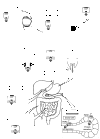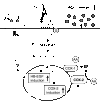Gastrointestinal roles for proteinase-activated receptors in health and disease
- PMID: 17994114
- PMCID: PMC2268065
- DOI: 10.1038/sj.bjp.0707491
Gastrointestinal roles for proteinase-activated receptors in health and disease
Abstract
It has been almost a decade since the molecular cloning of all four members of the proteinase-activated receptor (PAR) family was completed. This unique family of G protein-coupled receptors (GPCRs) mediates specific cellular actions of various endogenous proteinases including thrombin, trypsin, tryptase, etc. and also certain exogenous enzymes. Increasing evidence has been clarifying the emerging roles played by PARs in health and disease. PARs, particularly PAR1 and PAR2, are distributed throughout the gastrointestinal (GI) tract, modulating various GI functions. One of the most important GI functions of PARs is regulation of exocrine secretion in the salivary glands, pancreas and GI mucosal epithelium. PARs also modulate motility of GI smooth muscle, involving multiple mechanisms. PAR2 appears to play dual roles in pancreatitis and related pain, being pro-inflammatory/pro-nociceptive and anti-inflammatory/anti-nociceptive. Similarly, dual roles for PAR1 and PAR2 have been demonstrated in mucosal inflammation/damage throughout the GI tract. There is also fundamental and clinical evidence for involvement of PAR2 in colonic pain. PARs are thus considered key molecules in regulation of GI functions and targets for development of drugs for treatment of various GI diseases.
Figures




Similar articles
-
Gastrointestinal functions of proteinase-activated receptors.Life Sci. 2003 Dec 5;74(2-3):247-54. doi: 10.1016/j.lfs.2003.09.011. Life Sci. 2003. PMID: 14607252 Review.
-
Proteinase-activated receptors in the gastrointestinal system: a functional linkage to prostanoids.Inflammopharmacology. 2007 Dec;15(6):246-51. doi: 10.1007/s10787-007-1591-3. Inflammopharmacology. 2007. PMID: 18236015 Review.
-
[Development of agonists/antagonists for protease-activated receptors (PARs) and the possible therapeutic application to gastrointestinal diseases].Yakugaku Zasshi. 2005 Jun;125(6):491-8. doi: 10.1248/yakushi.125.491. Yakugaku Zasshi. 2005. PMID: 15930817 Review. Japanese.
-
Protease-activated receptors: novel central role in modulation of gastric functions.Neurogastroenterol Motil. 2010 Apr;22(4):361-5. doi: 10.1111/j.1365-2982.2010.01475.x. Neurogastroenterol Motil. 2010. PMID: 20377791
-
Physiology and pathophysiology of proteinase-activated receptors (PARs): PARs in the respiratory system: cellular signaling and physiological/pathological roles.J Pharmacol Sci. 2005 Jan;97(1):20-4. doi: 10.1254/jphs.fmj04005x4. Epub 2005 Jan 15. J Pharmacol Sci. 2005. PMID: 15655298 Review.
Cited by
-
Involvement of PAR2 in platelet-derived growth factor receptor-α-positive cell proliferation in the colon of diabetic mice.Physiol Rep. 2021 Nov;9(21):e15099. doi: 10.14814/phy2.15099. Physiol Rep. 2021. PMID: 34755491 Free PMC article.
-
Macrophage-derived HMGB1 as a Pain Mediator in the Early Stage of Acute Pancreatitis in Mice: Targeting RAGE and CXCL12/CXCR4 Axis.J Neuroimmune Pharmacol. 2017 Dec;12(4):693-707. doi: 10.1007/s11481-017-9757-2. Epub 2017 Jul 28. J Neuroimmune Pharmacol. 2017. PMID: 28755135
-
Expression of Proteinase-Activated Receptor 2 During Colon Volvulus in the Horse.Front Vet Sci. 2020 Nov 27;7:589367. doi: 10.3389/fvets.2020.589367. eCollection 2020. Front Vet Sci. 2020. PMID: 33330716 Free PMC article.
-
PAR2 regulates regeneration, transdifferentiation, and death.Cell Death Dis. 2016 Nov 3;7(11):e2452. doi: 10.1038/cddis.2016.357. Cell Death Dis. 2016. PMID: 27809303 Free PMC article.
-
Modulating human proteinase activated receptor 2 with a novel antagonist (GB88) and agonist (GB110).Br J Pharmacol. 2012 Mar;165(5):1413-23. doi: 10.1111/j.1476-5381.2011.01610.x. Br J Pharmacol. 2012. PMID: 21806599 Free PMC article.
References
-
- Alvarez C, Regan JP, Merianos D, Bass BL. Protease-activated receptor-2 regulates bicarbonate secretion by pancreatic duct cells in vitro. Surgery. 2004;136:669–676. - PubMed
-
- Arisawa T, Tahara T, Shibata T, Nagasaka M, Nakamura M, Kamiya Y, et al. Promoter hypomethylation of protease-activated receptor 2 associated with carcinogenesis in the stomach. J Gastroenterol Hepatol. 2007;22:943–948. - PubMed
-
- Asokananthan N, Graham PT, Fink J, Knight DA, Bakker AJ, McWilliam AS, et al. Activation of protease-activated receptor (PAR)-1, PAR-2, and PAR-4 stimulates IL-6, IL-8, and prostaglandin E2 release from human respiratory epithelial cells. J Immunol. 2002;168:3577–3585. - PubMed
-
- Barbara G, Wang B, Stanghellini V, de Giorgio R, Cremon C, Di Nardo G, et al. Mast cell-dependent excitation of visceral-nociceptive sensory neurons in irritable bowel syndrome. Gastroenterology. 2007;132:26–37. - PubMed
Publication types
MeSH terms
Substances
LinkOut - more resources
Full Text Sources
Other Literature Sources
Miscellaneous

